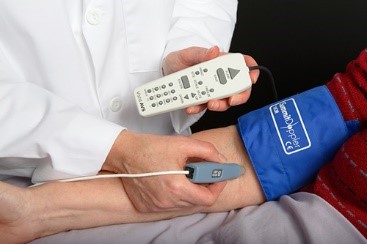Diagnosis of Peripheral Arterial Disease (P.A.D.)
The non-invasive gold-standard for diagnosing P.A.D. is the ABI exam, a simple non-invasive test that compares the systolic pressures in the seated or supine position. Segmental studies are performed on patients with P.A.D. to localize the occlusion in the lower limbs.
Early Detection of P.A.D. is the key
P.A.D is a common condition that affects 8 to 12 million people in the U.S. every year. It is characterized by the narrowing of the arteries in the legs due to atherosclerosis. Most common among diabetics and older adults, P.A.D. is under-diagnosed and under-treated, resulting in many patients at high-risk for heart attack, stroke, leg amputation and even death. Early detection of P.A.D. is the key to preventing severe cardiovascular events.
Undetected P.A.D. is associated with the following health issues:
- 2 to 3 fold increase in mortality
- 2 to 6 fold increase in heart attack, stroke, amputation and death
- Leg amputation (150,000 annually)
P.A.D. is more common than heart disease, cancer and stroke. Most people who have the disease may not have symptoms. In fact, less than 30% of P.A.D. Patients have symptoms. If untreated, P.A.D. can lead to critical limb ischemia (CLI) causing gangrene, resulting in possible leg amputations. The most common symptom is claudication, pain or cramping in the legs that occurs when waking or exercising and usually subsides when at rest. Too often, claudication is misinterpreted as normal aging or arthritis pain. If a patient is experiencing claudication, it is important to determine if the pain is due to P.A.D. and begin treatment as needed.
P.A.D. Risk Factors and Symptoms
- 65+ years of age
- Smokers 50+ years of age
- Diabetics 50+ years of age
- Diabetics < 49 years of age with 1 or more risk factors (e.g. smoking, high blood pressure, stroke)
- Abnormal pulses during exam
- Claudication in the leg or chronic leg pain
- Critical limb ischemia (CLI)
- Known history of Coronary Artery Disease (CAD), Renal Artery Stenosis (RAS), Carotid Endarterectomy (CEA) and cardiovascular disease
- Framingham risk score >10-20%
Ankle Brachial Index Testing
The ankle-brachial index (ABI) test checks for PAD of the legs and is also used to predict the severity of PAD. A slight drop in your ABI with exercise means that you probably have PAD. This drop may be important, because PAD can be linked to a higher risk of heart attack or stroke.
This test might be done to check your risk of heart attack and stroke. The results can help you and your doctor make decisions about how to lower your risk. It is also used to see how well a treatment is working (such as medical treatment, an exercise program, angioplasty, or surgery).
A lower ABI means you might have PAD. A slight drop in the ABI with exercise, even if you have a normal ABI at rest, means that you probably have PAD.

